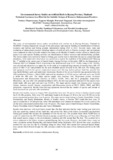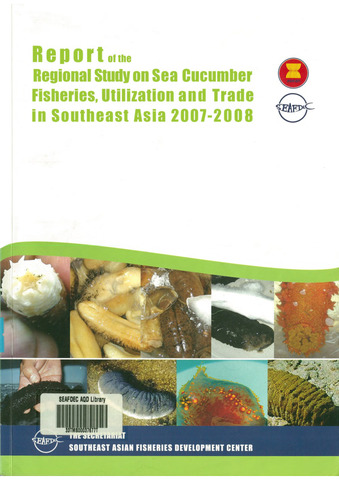Environmental Survey Studies on Artificial Reefs in Rayong Province, Thailand: Technical Assistance in a Pilot Site for Suitable Designs of Resource Enhancement Practices
Share
นามธรรม
The series of environmental survey studies on artificial reefs carried out in Rayong Province, Thailand by SEAFDEC Training Department was part of the pilot project and capacity building on rehabilitation of fisheries resources and habitats and fishing grounds implemented during 2010 to 2014. Selected onsite study and evaluation of enhancement practices including impacts of artificial reefs to fisheries resources and environment were conducted in order to provide technical assistance to the Member Countries in their efforts to identify pilot project sites and capacity building activities on rehabilitation of fishery resources and habitats/fishing grounds. The survey studies were carried out based on fishing gear used in order to determine the species composition and abundance, while underwater observation was carried out to inspect the conditions of the artificial reefs 'Rayong No. 2' installed at the eastern part of Samed Island, Rayong Province in December 2009 by the Department of Fisheries (DOF) of Thailand. The G-18 position of the artificial reefs (Lat. N 12 degree 31.085, Long. E 101 degree 30.830), was selected and referred to as a major site for the study as it comprised large amount of concrete block ARs (35 pieces of ARs 1.5 m super(3)) and probably has the most abundant species diversity in the ARs area. The fishing gears and equipment used for the species composition survey were fish trap, bottom gill-net, hand line, juvenile fish trap, Smith-McIntyre grab, and underwater observation. Results of the survey from fish trap operation before the ARs installation (February - March 2009) indicated the abundance of 18 fish species, and total catch was 52,658 g inside the ARs area. The major species caught were Lutjanus vitta, Diagramma pictum, Scolopsis monogramma and Monacanthus chinensis at 1863.3, 1520.8, 348.3, and 162.5 g/trap/time, respectively. Meanwhile, one year after ARs installation (March 2011), the fish trap operation indicated 12 fish species were found inside ARs area, and total catch was 22,520 g. The major species caught were Siganus javas, Lutjanus lyjanus, Lutjanus russelli, Siganus canaliculatus and Diagramma pictum at 202.5, 1360.0, 500.0, and 500.0 g/trap/time, respectively. Results from fish trap operations showed that the number of species and amount of catch decreased one year after ARs installation. Results from benthos survey in August 2011 showed that there were 26 species of macro benthos found around the G-18 ARs position. There were 531 individuals found at the distance of 50 m to the west (W-50) yet in the most concentrated position there were 8 species. The major species found belong to Family Capitellidae, Family Pectinariidae and Family Maldanidae. Results of benthos survey in October 2012 found that there were 31 species around the G-18 ARs position, where 968 individuals were found at the distance 50 m to the south (S-50) yet the most concentrated position there were 10 species. The major species found belong to Family Capetellidae, Family Nereididae, Family Onuphidae, and Family Maldanida. Results from interview with local fishers around Ban Phe Bay indicated that the major fishing gear used were fish trap, squid trap, bottom gill-net, hand line, and towing-line. Most of the fishers occasionally operated their fishing gear around ARs because the abundance of fish was not rich. The accident where about 50,000 liters of crude oil leaked from the PTT Global Chemical pipeline around 20 km off the coast of Rayong on 27 July 2013 had caused massive impact to the environmental condition and ARs around Ban Phe Bay. This accident led to severe reduction of the fishery resources around Rayong Bay for a year. However, the results from a study on water circulation around Rayong Bay and Samed Island during September 2013 showed that water circulation around ARs area was less due to a blockage along the shore where tidal current flow eastward Samed Island. Less current which flowed through the ARs structures could be the cause of less biological growth in the ARs areas.
การอ้างอิง
Theparoonrat, Y., Manajit, N., Yingyuad, W., Amornpiyakrit, T., Tanvilai, R., Suksamran, N., & Leardpraseart, W. (2016). Environmental survey studies on artificial reefs in Rayong Province, Thailand: Technical assistance in a pilot site for suitable designs of resource enhancement practices. In H. Kawamura, T. Iwata, Y. Theparoonrat, N. Manajit, & V. T. Sulit (Eds.), Consolidating the Strategies for Fishery Resources Enhancement in Southeast Asia. Proceedings of the Symposium on Strategy for Fisheries Resources Enhancement in the Southeast Asian Region, Pattaya, Thailand, 27-30 July 2015 (pp. 44-48). Samutprakan, Thailand: Training Department, Southeast Asian Fisheries Development Center.
เรื่อง
biological production  ; resource conservation
; resource conservation  ; abundance
; abundance  ; fishing gear
; fishing gear  ; environmental impact
; environmental impact  ; check lists
; check lists  ; habitat improvement (physical)
; habitat improvement (physical)  ; Habitat; fishery resources
; Habitat; fishery resources  ; artificial reefs
; artificial reefs  ; catch composition
; catch composition  ; socioeconomic aspects
; socioeconomic aspects  ; fishery surveys
; fishery surveys  ; water currents
; water currents  ; trap nets
; trap nets  ; species diversity
; species diversity  ; resource surveys
; resource surveys  ; fishing grounds
; fishing grounds  ; water circulation
; water circulation  ; benthos
; benthos  ; environmental surveys
; environmental surveys  ; Thailand; Maldanidae; Lutjanus vita; Siganus canaliculatus; Capitellidae; Nereididae; Pectinariidae; Monacanthus chinensis javas; Lutjanus russelli; Lutjanus lyjanus; Scolopsis monogramma; Onuphidae; Diagramma pictum
; Thailand; Maldanidae; Lutjanus vita; Siganus canaliculatus; Capitellidae; Nereididae; Pectinariidae; Monacanthus chinensis javas; Lutjanus russelli; Lutjanus lyjanus; Scolopsis monogramma; Onuphidae; Diagramma pictum
 ; resource conservation
; resource conservation  ; abundance
; abundance  ; fishing gear
; fishing gear  ; environmental impact
; environmental impact  ; check lists
; check lists  ; habitat improvement (physical)
; habitat improvement (physical)  ; Habitat; fishery resources
; Habitat; fishery resources  ; artificial reefs
; artificial reefs  ; catch composition
; catch composition  ; socioeconomic aspects
; socioeconomic aspects  ; fishery surveys
; fishery surveys  ; water currents
; water currents  ; trap nets
; trap nets  ; species diversity
; species diversity  ; resource surveys
; resource surveys  ; fishing grounds
; fishing grounds  ; water circulation
; water circulation  ; benthos
; benthos  ; environmental surveys
; environmental surveys  ; Thailand; Maldanidae; Lutjanus vita; Siganus canaliculatus; Capitellidae; Nereididae; Pectinariidae; Monacanthus chinensis javas; Lutjanus russelli; Lutjanus lyjanus; Scolopsis monogramma; Onuphidae; Diagramma pictum
; Thailand; Maldanidae; Lutjanus vita; Siganus canaliculatus; Capitellidae; Nereididae; Pectinariidae; Monacanthus chinensis javas; Lutjanus russelli; Lutjanus lyjanus; Scolopsis monogramma; Onuphidae; Diagramma pictum
รายการที่เกี่ยวข้อง
แสดงรายการที่เกี่ยวข้องตามชื่อผู้แต่งผู้สร้างและเรื่อง
-
Report of the regional study on sea cucumber fisheries, utilization, and trade in Southeast Asia, 2007-2008
Southeast Asian Fisheries Development Center (Secretariat, Southeast Asian Fisheries Development Center, 2009)The present trend towards overfishing of sea cucumbers in diverse geographical areas to supply international market demand has become an urgent concern in the international community. There is also an attempt to conserve ... -
Proceedings of the Regional Seminar on Integrated Coastal Resources Management in Southeast Asia: Lessons Learned through Integrated Coastal Resources Management in Pathew District, Chumphon Province (ICRM-PD)
Training Department, Southeast Asian Fisheries Development Center (Training Department, Southeast Asian Fisheries Development Center, 2007-09)The proceedings contain the papers that were presented at a regional seminar on integrated coastal resources management. The seminar was conducted to 1) report the achievement and outcome of the project during its 5-year ... -
Monitoring Socio-economics of the ICRM Project Pathew District, Chumphon Province
Suasi, Thanyalak (Training Department, Southeast Asian Fisheries Development Center, 2007)The paper contains the results of the two socio-economic surveys of the integrated coastal resource management projects that were conducted in Pakklong Sub-District, Pathew District, Chumphon Province in Thailand. The first ...




